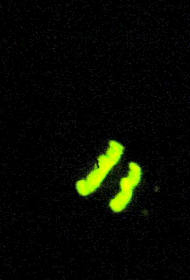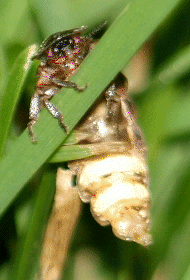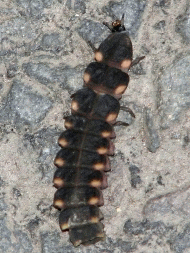
Consulting Entomologist

Tel/Fax: 01275 854224
E-Mail: [email protected]
Site Guide
Site Search
Home Page
Career Page
Insect Files
- Contents
- Bug Index
- The World of Bugs
- Classification of Bugs
- Insect Identification
- Insect Fossils
- Insect Body-parts
- Micro View of Bugs
- Insect Life Cycles
- Insect Defences
- Insects of Nailsea
- Pesticide Safety
- Bibliography
Shortcut to the main groups of insects and other arthropods...
Bug Rhymes & Poems
Links
Shop
Payments (credit/debit card)
Glow-worms & Fire-flies |
Class: Insecta Order: Coleoptera | |
|
Famed for their ability to emit light - the glow-worm was aptly described by Wordsworth | ||
|
Glow-worms and fire-flies belong to a family of beetles called the Lampyridae. In Britain there are just two native species - the common glow-worm (Lampyris noctiluca) and the lesser glow-worm (Phosphaenus hemipterus). The latter, however, is very rare and confined as a British species to a few small, elusive colonies in the southern counties of England. The glow-worm derives its name from the remarkable ability to emit light, a characteristic shared by all members of the Lampyridae, and from the larviform (or worm-like) appearance of the wingless female. The male is a more typical beetle, being fully winged and able to fly. The female is larger than the male, often nearly twice his size (see picture opposite). |
showing a winged male mating with the larger, wingless female (male 10-13 mm long, female up to 25 mm long) Photo: W. Hester © 2004 |
|
(Lampyris noctiluca) with its terminal segments glowing in the dark Photo: W. Hester © 2004 |
The light-producing (or photogenic) organs of the female glow-worm (Lampyris noctiluca) are contained in the last three abdominal segments and consist of a layer of protein, called luciferin, backed by a reflector layer of minute chrystals. Light is produced by enzymatic oxidation of the luciferin in the presence of oxygen and water. Nearly all the chemical energy of this reaction is converted into light - very little heat is produced. The luciferin layer is well supplied with tracheae (air-tubes) to ensure a good supply of oxygen. The light emitted is pale green, as shown in the left-hand picture. The beetle can switch its light on and off as required, by increasing and decreasing the air (and hence oxygen) supply to the luciferin layer. The outer cuticle on the underside where the photogenic organs are situated is uncoloured and translucent, so that these areas of the terminal segments appear much paler than the rest of the body, as shown in the right-hand picture. Although it is the female glow-worm that emits the strongest light, all stages of this insect are to some degree faintly luminescent, including the male beetles, larvae and eggs. |
(Lampyris noctiluca) with its paler photogenic terminal segments Photo: W. Hester © 2004 |
|
The function of the glow-worm's light is to attract the males. As dusk falls, the wingless females only need to sit in the grass and low vegetation, switch on their lights and turn their bodies so that their 'lamps' are visible to the males flying above. Male glow-worms have much larger eyes than the females and they quickly fly towards the light, so that a glowing female soon attracts a mate. After mating the female generally douses her light and gets on with the business of egg-laying. Some species of lampyrid beetles, usually referred to as fire-flies, are strongly luminescent in both sexes - the males flash their lights as they fly, and the females respond with their own flashes when they see the males overhead. Typical examples are the european fire-fly (Luciola lusitanica) and the redcurrant or lesser fire-fly (Lamprohiza = Phausis splendidula), found in southern and central Europe, respectively. | ||
|
In Britain, the common glow-worm (Lampyris noctiluca) is fairly widespread, but local in distribution. The beetles are usually found on grassy slopes, verges and hedgebanks, on heaths and in open grassland, especially in chalky and limestone areas. They are mainly nocturnal, the flying males sometimes coming to street and house lights (no doubt mistaking these artificial lights for a large glowing female!). The life-cycle may take one, two or even three years, with adults usually emerging in June-July, although they occasionally appear in May and some beetles may survive into October. The adult beetles take little or no food, but the larvae are predatory and feed on small slugs and snails. These are seized with their jaws and injected with a digestive fluid which liquefies the prey ready for eating. The larval stages somewhat resemble the wingless adult female apart from their smaller size, at least until they become fully mature and ready to pupate. A full-grown larva of Lampyris noctiluca, with its distinctive pale spots on each body segment, is illustrated on the right. The larvae are ground-dwellers, generally living under stones, logs and similar sheltered places, but sometimes seen crawling on grass, pathways and roads (like the specimen in the photograph). |
Photo: D. Wright © 2007 | |
|
Glow-worm populations in Britain have been the subject of two national surveys, the first by Anthony Wootton for the British Naturalists' Association in the early 1970s (reported in: Country-Side 1971, 21, 456-463, 572-574; 1974, 22, 266-271), and the second by Robin Scagell as a privately-funded study started in 1990. For details of the latter survey (which includes county records from the earlier Wootton survey) and further information about glow-worms go to the UK Glow-Worm Survey, an excellent site both for the enthusiast and the casual observer of these fascinating beetles. |
||
|
MORE ON BEETLES Order Coleoptera <<< HERE >>> |
| <<< TOP | (use the back button on your web browser to return to the previous page) | TOP >>> |



